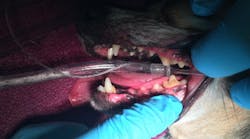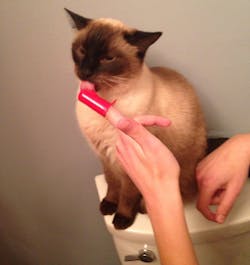Human versus veterinary dentistry: What dental hygienists should know
A veterinarian begins examining the teeth of puppies and kittens starting at their very first vaccination appointment, around eight weeks of age, and continues to evaluate the mouth at every following appointment to check for maladies, including misaligned teeth, retained deciduous teeth, and unerupted teeth. Most veterinarians recommend a yearly dental examination and prophylaxis, as opposed to the six-month recommendation for humans.
The role of anesthesia
The veterinary dental prophylaxis is a surgical procedure requiring general anesthesia. Prior to the procedure, the pet is thoroughly evaluated and has preanesthetic bloodwork performed to look for underlying diseases that could increase the risk of anesthesia. Once approved for surgery, the animal is given an injectable premedication to provide sedation, an IV catheter is then placed, and the pet is induced for anesthesia. While under general anesthesia, the animal receives IV fluids and constant monitoring of blood pressure, heart rhythm, pulse oxygenation, and temperature. If extractions are needed, dental nerve blocks are provided and the patient is sent home with oral pain medications and antibiotics as needed.
READ MORE | A dentist for all species
General anesthesia is the only way a thorough prophylaxis can be performed on a veterinary patient. There are few, if any, dogs or cats willing to hold still to allow scaling and polishing of their teeth, let alone dental radiographs and extractions. It would be dangerous for both pet and veterinarian. Because anesthesia is not a necessity, not an option, every risk is considered and minimized. Veterinarians reduce the risk of injury to the pet’s airway by using an endotracheal tube, which is inflated appropriately in the pet’s trachea to avoid water and contaminants entering the lungs. A technician monitors the veterinary patient and takes the dental radiographs, and the veterinarian examines the teeth and performs the nerve blocks and extractions.
Radiographs
Full-mouth radiographs for veterinary patients are performed in a way similar to how they are for human patients; they are evaluated for bone levels, fractures, abscesses, and any pathology. Not all veterinary hospitals have dental radiography, but it is certainly more commonplace today.
Prophylaxis
The prophylaxis is the most similar portion of the appointment, with probing, Cavitron, hand instruments, prophy angle and paste, and fluoride application all being present in both. This portion of the procedure could be done by a hygienist if he or she was trained on the specific anatomy of pet oral cavities, such as tooth morphology and tooth number, as well as breed-specific issues affecting oral health. For example, tiny breeds are prone to more dental issues, while short-faced dogs are at greater anesthetic risk due to inherent airway issues, as are dogs with Class III malocclusion.
The animal is positioned on its side and the near surfaces are treated first, and then the animal must be flipped to the other side for far surfaces to be accessible due to lost access from the endotracheal tube. The Cavitron must not rest long on any tooth surface, as the pulp can overheat, resulting in damage to the tooth and potential tooth death. Bone levels are measured and mobility tested. It is recommended to remove any teeth with significant periodontal conditions, fractures, and resorptive lesions to avoid future abscess. All extractions and diagnosis are performed by the veterinarian, and most often, at the time of the prophylaxis in order to avoid putting the patient under general anesthesia again.
After the dental prophylaxis is complete, extubation is performed once the animal attempts to swallow several times and can protect its own airway. The animal is then placed on warming blankets and is monitored every ten minutes for body temperature, heart rate, and respiratory rate until it is fully responsive. The IV catheter will be removed several hours later, before the pet is returned to the owner. Each dental procedure requires multiple caregivers, including technicians for anesthesia monitoring and prophylaxis, the veterinarian for the diagnosis and potential treatment, and the recovery technician who monitors the pet after the procedure in the recovery area.
Client education and home care
Client education plays a large role in preventing dental diseases at home in dogs and cats. It is recommended that clients brush their cat’s or dog’s teeth daily with enzymatic toothpaste using either a pet-specific finger brush or soft bristle human toothbrush. There are also dental treats and prescription dental diets that can be used to minimize tartar formation in between dental cleanings.
Each dental appointment comes with a reminder that xylitol, a product found in some human toothpastes and foods, is poisonous to pets and may lead to death. The kibbles in dental diets are harder and more porous than traditional kibble in order to physically scrape the pets’ teeth while eating, thus removing plaque and decreasing the amount of tartar production. Feeding bones to dogs can lead to tooth fractures and should be avoided.
The education about plaque, biofilm, gingivitis, and periodontal disease is consistent with our human patients. Decay issues are completely different, as most pets will never have issues with decay, but suffer many more fractures from continued bone chewing and rough play.
As with human dentistry treatment, recommendations may be declined. This is always a difficult subject to tackle. For pets, a dental examination and prophylaxis is the only way to definitively diagnose some oral health conditions. Most pets do not exhibit clinical signs of dental pain and symptoms may be difficult to interpret unless the pet is drooling excessively, has oral bleeding, dropping food, or having difficulty eating. When owners refuse diagnostic tools, diseases cannot always be managed and may lead to decreased eating, behavioral issues, halitosis, loss of teeth, and systemic disease, including toxemia and death.
Is it fair for hygienists to criticize veterinary fees?
It seems we have all recently read blog posts about hygienists wanting to do their own pet’s prophylaxis or questioning the cost of a pet dental procedure. It is a bit ironic that when our patients ask for justification of fees, procedures, and insurance estimates, we are so often irritated, and yet for our pet’s oral health, many in the dental community are doing the exact same thing.
It is important to understand in all procedures, both veterinary and human, what the fee entails and why it is necessary. Veterinary dental fees include blood work, general anesthesia, medications, IV fluids, full-mouth radiographs, prophylaxis, fluoride treatment, anesthesia monitoring, postoperative pain medications and antibiotics, and even a nail trim.
Differences between the professions
As with dental hygiene degrees, there are several options for veterinary degrees. For veterinary technicians, one option is an associate in applied science degree, usually requiring two years for completion, or a four-year bachelor of science degree; both are accredited by the American Veterinary Medical Association. Licensing requirements vary by state, and an examination is often required to be credentialed, certified, or registered. The salary of the veterinary technician varies by state, but is not equivalent to that of the dental hygienist. At this time, more employment postings were found for veterinary technicians, including those with full-time hours and a limited benefit package, than current dental hygiene positions available.
Registered dental hygienists may enjoy transitioning between pet and human dentistry, but extensive training and education will be required for the administration, monitoring, and anesthesia portion of the surgery. The prophylaxis and education portion could be performed if working under the direct supervision of a licensed veterinarian. There are a number of upsides to veterinary dentistry—there’s no “turn toward me” moments, all of your patients will be fully anesthetized, and if you are very lucky, you will get some great snuggles and licks. The bottom line is that if you love animals and want to see that they too have excellent oral health and home-care instruction, then veterinary dentistry may be for you.
Resources
The American Veterinary Dental College (AVDC) says, “even though you may be highly qualified in the human dental field, Veterinary Medical Practice Acts in US states and Canadian provinces require that any dental work done on veterinary patients must be done by or under the supervision of a licensed veterinarian.” Read more of their information for health professionals here.
You can read the AVDC position statement on veterinary dental health-care providers here. According to the AVDC, the statement was “developed… as a means to safeguard the veterinary dental patient and to ensure the qualifications of persons performing veterinary dental procedures.”
For further information about veterinary dentistry, please visit the Veterinary Oral Health Council and the American Veterinary Dental College websites.
The author wishes to thank Jessica L. Manassa, DVM, and her colleagues for their assistance with this article.
Editor's note: This article was originally published in 2018 and has been updated as of September 2025.
About the Author
Debra Viger, RDH
Debra Viger, RDH, has 30 years of clinical dental hygiene, dental office management, and treatment coordination experience. She is past director of outreach for Little City Foundation, where she taught daily home care techniques, nutrition for dental health, and desensitization for the developmentally delayed and autistic community. She is past president of McHenry County Dental Hygiene Society and past chair of continuing education. She has published in both RDH, Access Magazine and Today’s RDH.

